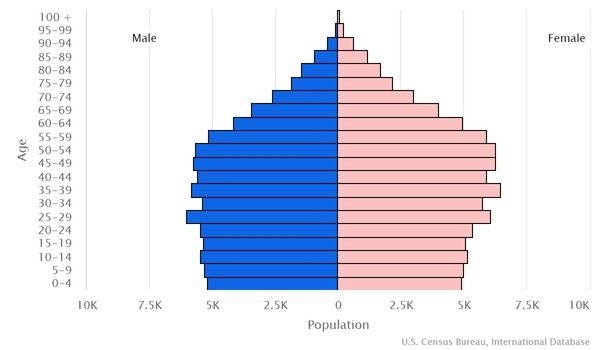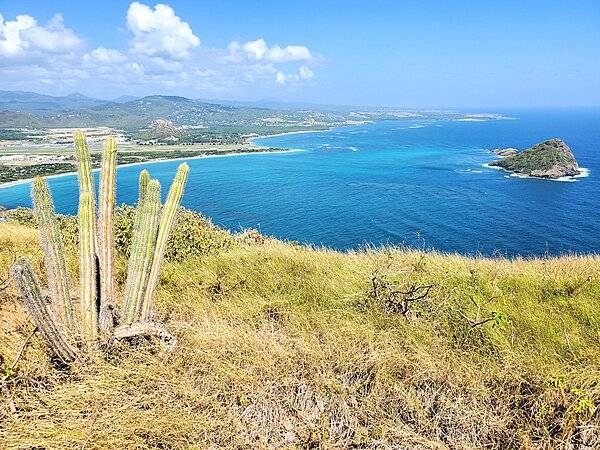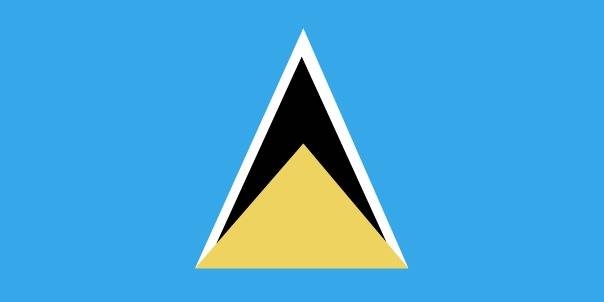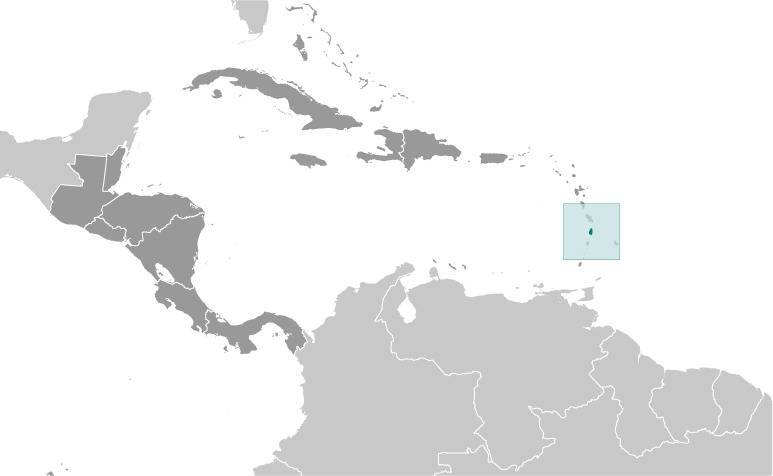Introduction
Background
The island, with its fine natural harbor at Castries and burgeoning sugar industry, was contested by England and France throughout the 17th and early 18th centuries (changing possession 14 times); it was finally ceded to the UK in 1814 and became part of the British Windward Islands colony. Even after the abolition of slavery on its plantations in 1834, Saint Lucia remained an agricultural island, dedicated to producing tropical commodity crops. In the mid-20th century, Saint Lucia joined the West Indies Federation (1958–1962) and in 1967 became one of the six members of the West Indies Associated States, with internal self-government. In 1979, Saint Lucia gained full independence.
Visit the Definitions and Notes page to view a description of each topic.
Geography
Location
Caribbean, island between the Caribbean Sea and North Atlantic Ocean, north of Trinidad and Tobago
Geographic coordinates
13 53 N, 60 58 W
Map references
Central America and the Caribbean
Area - comparative
three and a half times the size of Washington, DC
Land boundaries
total: 0 km
Coastline
158 km
Maritime claims
territorial sea: 12 nm
contiguous zone: 24 nm
exclusive economic zone: 200 nm
continental shelf: 200 nm or to the edge of the continental margin
Climate
tropical, moderated by northeast trade winds; dry season January to April, rainy season May to August
Terrain
volcanic and mountainous with broad, fertile valleys
Elevation
highest point: Mount Gimie 948 m
lowest point: Caribbean Sea 0 m
Natural resources
forests, sandy beaches, minerals (pumice), mineral springs, geothermal potential
Land use
agricultural land: 17.4% (2018 est.)
arable land: 4.9% (2018 est.)
permanent crops: 11.5% (2018 est.)
permanent pasture: 1% (2018 est.)
forest: 77% (2018 est.)
other: 5.6% (2018 est.)
Irrigated land
30 sq km (2012)
Population distribution
most of the population is found on the periphery of the island, with a larger concentration in the north around the capital of Castries
Natural hazards
hurricanes
volcanism: Mount Gimie (948 m), also known as Qualibou, is a caldera on the west of the island; the iconic twin pyramidal peaks of Gros Piton (771 m) and Petit Piton (743 m) are lava dome remnants associated with the Soufriere volcano; there have been no historical magmatic eruptions, but a minor steam eruption in 1766 spread a thin layer of ash over a wide area; Saint Lucia is part of the volcanic island arc of the Lesser Antilles that extends from Saba in the north to Grenada in the south
Geography - note
the twin Pitons (Gros Piton and Petit Piton), striking cone-shaped peaks south of Soufriere, are one of the scenic natural highlights of the Caribbean
People and Society
Nationality
noun: Saint Lucian(s)
adjective: Saint Lucian
Ethnic groups
Black/African descent 85.3%, mixed 10.9%, East Indian 2.2%, other 1.6%, unspecified 0.1% (2010 est.)
Languages
English (official), Saint Lucian Creole
Religions
Roman Catholic 61.5%, Protestant 25.5% (includes Seventh Day Adventist 10.4%, Pentecostal 8.9%, Baptist 2.2%, Anglican 1.6%, Church of God 1.5%, other Protestant 0.9%), other Christian 3.4% (includes Evangelical 2.3% and Jehovah's Witness 1.1%), Rastafarian 1.9%, other 0.4%, none 5.9%, unspecified 1.4% (2010 est.)
Age structure
0-14 years: 19.24% (male 16,484/female 15,546)
15-24 years: 13.6% (male 11,475/female 11,165)
25-54 years: 42.83% (male 34,436/female 36,868)
55-64 years: 11.23% (male 8,624/female 10,075)
65 years and over: 13.1% (male 9,894/female 11,920) (2020 est.)

Dependency ratios
total dependency ratio: 37.7
youth dependency ratio: 25.2
elderly dependency ratio: 12.5
potential support ratio: 8 (2021 est.)
Median age
total: 36.9 years
male: 35.7 years
female: 38 years (2020 est.)
Population distribution
most of the population is found on the periphery of the island, with a larger concentration in the north around the capital of Castries
Urbanization
urban population: 19.2% of total population (2023)
rate of urbanization: 0.98% annual rate of change (2020-25 est.)
Major urban areas - population
22,000 CASTRIES (capital) (2018)
Sex ratio
at birth: 1.06 male(s)/female
0-14 years: 1.06 male(s)/female
15-24 years: 1.04 male(s)/female
25-54 years: 0.94 male(s)/female
55-64 years: 0.86 male(s)/female
65 years and over: 0.75 male(s)/female
total population: 0.94 male(s)/female (2022 est.)
Maternal mortality ratio
117 deaths/100,000 live births (2017 est.)
country comparison to the world: 67Infant mortality rate
total: 11.99 deaths/1,000 live births
male: 11.23 deaths/1,000 live births
female: 12.78 deaths/1,000 live births (2022 est.)
Life expectancy at birth
total population: 78.95 years
male: 76.21 years
female: 81.84 years (2022 est.)
Contraceptive prevalence rate
55.5% (2011/12)
Drinking water source
improved: urban: 99.4% of population
rural: 98.5% of population
total: 98.7% of population
unimproved: urban: 0.6% of population
rural: 1.5% of population
total: 1.3% of population (2020 est.)
Current health expenditure
4.3% of GDP (2019)
Physicians density
0.64 physicians/1,000 population (2017)
Hospital bed density
1.3 beds/1,000 population (2017)
Sanitation facility access
improved: urban: 97.6% of population
rural: 92.9% of population
total: 93.8% of population
unimproved: urban: 2.4% of population
rural: 7.1% of population
total: 6.2% of population (2020 est.)
Alcohol consumption per capita
total: 9.3 liters of pure alcohol (2019 est.)
beer: 3.21 liters of pure alcohol (2019 est.)
wine: 0.4 liters of pure alcohol (2019 est.)
spirits: 5.1 liters of pure alcohol (2019 est.)
other alcohols: 0.6 liters of pure alcohol (2019 est.)
Literacy
total population: NA
male: NA
female: NA
School life expectancy (primary to tertiary education)
total: 13 years
male: 12 years
female: 13 years (2020)
Youth unemployment rate (ages 15-24)
total: 44.7%
male: 46.4%
female: 42.6% (2021 est.)
Environment
Environment - current issues
deforestation; soil erosion, particularly in the northern region
Environment - international agreements
party to: Biodiversity, Climate Change, Climate Change-Kyoto Protocol, Climate Change-Paris Agreement, Comprehensive Nuclear Test Ban, Desertification, Endangered Species, Environmental Modification, Hazardous Wastes, Law of the Sea, Marine Dumping-London Convention, Ozone Layer Protection, Ship Pollution, Wetlands, Whaling
signed, but not ratified: none of the selected agreements
Air pollutants
particulate matter emissions: 21.22 micrograms per cubic meter (2016 est.)
carbon dioxide emissions: 0.41 megatons (2016 est.)
methane emissions: 0.27 megatons (2020 est.)
Climate
tropical, moderated by northeast trade winds; dry season January to April, rainy season May to August
Land use
agricultural land: 17.4% (2018 est.)
arable land: 4.9% (2018 est.)
permanent crops: 11.5% (2018 est.)
permanent pasture: 1% (2018 est.)
forest: 77% (2018 est.)
other: 5.6% (2018 est.)
Urbanization
urban population: 19.2% of total population (2023)
rate of urbanization: 0.98% annual rate of change (2020-25 est.)
Revenue from forest resources
forest revenues: 0.01% of GDP (2018 est.)
country comparison to the world: 156Waste and recycling
municipal solid waste generated annually: 77,616 tons (2015 est.)
Total water withdrawal
municipal: 12.5 million cubic meters (2017 est.)
industrial: 0 cubic meters (2017 est.)
agricultural: 30.4 million cubic meters (2017 est.)
Total renewable water resources
300 million cubic meters (2017 est.)
Government
Country name
conventional long form: none
conventional short form: Saint Lucia
etymology: named after Saint LUCY of Syracuse by French sailors who were shipwrecked on the island on 13 December 1502, the saint's feast day; Saint Lucia is the only country named specifically after a woman
note: pronounced saynt-looshuh
Government type
parliamentary democracy under a constitutional monarchy; a Commonwealth realm
Capital
name: Castries
geographic coordinates: 14 00 N, 61 00 W
time difference: UTC-4 (1 hour ahead of Washington, DC, during Standard Time)
etymology: in 1785, the village of Carenage was renamed Castries, after Charles Eugene Gabriel de La Croix de CASTRIES (1727-1801), who was then the French Minister of the Navy and Colonies
Administrative divisions
10 districts; Anse-la-Raye, Canaries, Castries, Choiseul, Dennery, Gros-Islet, Laborie, Micoud, Soufriere, Vieux-Fort
Independence
22 February 1979 (from the UK)
National holiday
Independence Day, 22 February (1979)
Constitution
history: previous 1958, 1960 (preindependence); latest presented 20 December 1978, effective 22 February 1979
amendments: proposed by Parliament; passage requires at least two-thirds majority vote by the House of Assembly membership in the final reading and assent of the governor general; passage of amendments to various constitutional sections, such as those on fundamental rights and freedoms, government finances, the judiciary, and procedures for amending the constitution, require at least three-quarters majority vote by the House and assent of the governor general; passage of amendments approved by the House but rejected by the Senate require a majority of votes cast in a referendum; amended several times, last in 2008
Legal system
English common law
International law organization participation
has not submitted an ICJ jurisdiction declaration; accepts ICCt jurisdiction
Citizenship
citizenship by birth: yes
citizenship by descent only: at least one parent must be a citizen of Saint Lucia
dual citizenship recognized: yes
residency requirement for naturalization: 8 years
Suffrage
18 years of age; universal
Executive branch
chief of state: King CHARLES III (since 8 September 2022); represented by Acting Governor General Errol CHARLES (since 11 November 2021)
head of government: Prime Minister Philip J. PIERRE (since 28 July 2021)
cabinet: Cabinet appointed by the governor general on the advice of the prime minister
elections/appointments: the monarchy is hereditary; governor general appointed by the monarch; following legislative elections, the leader of the majority party or majority coalition usually appointed prime minister by governor general; deputy prime minister appointed by governor general
Legislative branch
description: bicameral Houses of Parliament consists of:
Senate (11 seats; all members appointed by the governor general; 6 on the advice of the prime minister, 3 on the advice of the leader of the opposition, and 2 upon consultation with religious, economic, and social groups; members serve 5-year terms)
House of Assembly (18 seats; 17 members directly elected in single-seat constituencies by simple majority vote and the speaker, designated from outside the Parliament; members serve 5-year terms)
elections: Senate - last appointments on 17 August 2021 (next in 2026)
House of Assembly - last held on 26 July 2021 (next to be held in 2026)
election results: Senate - percent of vote by party - NA; seats by party - NA; composition - men 6, women 5, percent of women 45.5%
House of Assembly - percent of vote by party - SLP 50.1%, UWP 42.9%, other o.3%, independent 6.6%; seats by party - SLP 13, UWP 2, independent 2; composition (including the speaker) - men 16, women 2, percent of women 11.1%; note - total Parliament percent of women 24.1%
Judicial branch
highest court(s): the Eastern Caribbean Supreme Court (ECSC) is the superior court of the Organization of Eastern Caribbean States; the ECSC - headquartered on St. Lucia - consists of the Court of Appeal - headed by the chief justice and 4 judges - and the High Court with 18 judges; the Court of Appeal is itinerant, traveling to member states on a schedule to hear appeals from the High Court and subordinate courts; High Court judges reside in the member states with 4 on Saint Lucia; Saint Lucia is a member of the Caribbean Court of Justice
judge selection and term of office: chief justice of Eastern Caribbean Supreme Court appointed by Her Majesty, Queen ELIZABETH II; other justices and judges appointed by the Judicial and Legal Services Commission, an independent body of judicial officials; Court of Appeal justices appointed for life with mandatory retirement at age 65; High Court judges appointed for life with mandatory retirement at age 62
subordinate courts: magistrate's court
Political parties and leaders
Saint Lucia Labor Party or SLP [Philip J. PIERRE]
United Workers Party or UWP [Allen M. CHASTANET]
International organization participation
ACP, AOSIS, C, Caricom, CD, CDB, CELAC, FAO, G-77, IBRD, ICAO, ICCt, ICRM, IDA, IFAD, IFC, IFRCS, ILO, IMF, IMO, Interpol, IOC, ISO, ITU, ITUC (NGOs), MIGA, NAM, OAS, OECS, OIF, OPANAL, OPCW, Petrocaribe, UN, UNCTAD, UNESCO, UNIDO, UPU, WCO, WFTU (NGOs), WHO, WIPO, WMO, WTO
Diplomatic representation in the US
chief of mission: Ambassador Elizabeth DARIUS-CLARKE (since 7 June 2022)
chancery: 1629 K Street NW, Suite 1250, Washington, DC 20006
telephone: [1] (202) 364-6792
FAX: [1] (202) 364-6723
email address and website:
embassydc@gosl.gov.lc
https://www.embassyofstlucia.org/
consulate(s) general: New York
Diplomatic representation from the US
embassy: the US does not have an embassy in Saint Lucia; the US Ambassador to Barbados is accredited to Saint Lucia
Flag description
cerulean blue with a gold isosceles triangle below a black arrowhead; the upper edges of the arrowhead have a white border; the blue color represents the sky and sea, gold stands for sunshine and prosperity, and white and black the racial composition of the island (with the latter being dominant); the two major triangles invoke the twin Pitons (Gros Piton and Petit Piton), cone-shaped volcanic plugs that are a symbol of the island
National symbol(s)
twin pitons (volcanic peaks), Saint Lucia parrot; national colors: cerulean blue, gold, black, white
National anthem
name: "Sons and Daughters of St. Lucia"
lyrics/music: Charles JESSE/Leton Felix THOMAS
note: adopted 1967
National heritage
total World Heritage Sites: 1 (natural)
selected World Heritage Site locales: Pitons Management Area
Economy
Economic overview
The island nation has been able to attract foreign business and investment, especially in its offshore banking and tourism industries. Tourism is Saint Lucia's main source of jobs and income - accounting for 65% of GDP - and the island's main source of foreign exchange earnings. The manufacturing sector is the most diverse in the Eastern Caribbean area. Crops such as bananas, mangos, and avocados continue to be grown for export, but St. Lucia's once solid banana industry has been devastated by strong competition.
Saint Lucia is vulnerable to a variety of external shocks, including volatile tourism receipts, natural disasters, and dependence on foreign oil. Furthermore, high public debt - 77% of GDP in 2012 - and high debt servicing obligations constrain the CHASTANET administration's ability to respond to adverse external shocks.
St. Lucia has experienced anemic growth since the onset of the global financial crisis in 2008, largely because of a slowdown in tourism - airlines cut back on their routes to St. Lucia in 2012. Also, St. Lucia introduced a value added tax in 2012 of 15%, becoming the last country in the Eastern Caribbean to do so. In 2013, the government introduced a National Competitiveness and Productivity Council to address St. Lucia's high public wages and lack of productivity.
Real GDP (purchasing power parity)
$2.25 billion (2020 est.)
$2.82 billion (2019 est.)
$2.78 billion (2018 est.)
note: data are in 2017 dollars
Real GDP growth rate
3% (2017 est.)
3.4% (2016 est.)
-0.9% (2015 est.)
Real GDP per capita
$12,300 (2020 est.)
$15,400 (2019 est.)
$15,300 (2018 est.)
note: data are in 2017 dollars
GDP (official exchange rate)
$1.686 billion (2017 est.)
Inflation rate (consumer prices)
0.1% (2017 est.)
-3.1% (2016 est.)
GDP - composition, by sector of origin
agriculture: 2.9% (2017 est.)
industry: 14.2% (2017 est.)
services: 82.8% (2017 est.)
GDP - composition, by end use
household consumption: 66.1% (2017 est.)
government consumption: 11.2% (2017 est.)
investment in fixed capital: 16.9% (2017 est.)
investment in inventories: 0.1% (2017 est.)
exports of goods and services: 62.7% (2017 est.)
imports of goods and services: -56.9% (2017 est.)
Agricultural products
bananas, coconuts, fruit, tropical fruit, plantains, roots/tubers, cassava, poultry, vegetables, mangoes/guavas
Industries
tourism; clothing, assembly of electronic components, beverages, corrugated cardboard boxes, lime processing, coconut processing
Labor force - by occupation
agriculture: 21.7%
industry: 24.7%
services: 53.6% (2002 est.)
Youth unemployment rate (ages 15-24)
total: 44.7%
male: 46.4%
female: 42.6% (2021 est.)
Population below poverty line
25% (2016 est.)
Gini Index coefficient - distribution of family income
51.2 (2016 est.)
country comparison to the world: 12Household income or consumption by percentage share
lowest 10%: NA
highest 10%: NA
Budget
revenues: 398.2 million (2017 est.)
expenditures: 392.8 million (2017 est.)
Fiscal year
1 April - 31 March
Current account balance
$21 million (2017 est.)
-$31 million (2016 est.)
Exports
$1.22 billion (2018 est.) note: data are in current year dollars
$188.2 million (2016 est.)
Exports - partners
United States 29%, Uruguay 16%, Barbados 8%, Trinidad and Tobago 5.5%, United Kingdom 6%, Dominica 6%, Guyana 5%, France 5% (2019)
Exports - commodities
crude petroleum, beer, jewelry, bananas, refined petroleum, rum (2019)
Imports
$1 billion (2018 est.) note: data are in current year dollars
$575.9 million (2016 est.)
Imports - partners
Colombia 46%, United States 30%, Trinidad and Tobago 5% (2019)
Imports - commodities
crude petroleum, refined petroleum, cars, poultry meats, natural gas (2019)
Reserves of foreign exchange and gold
$321.8 million (31 December 2017 est.)
$320.7 million (31 December 2016 est.)
Debt - external
$570.6 million (31 December 2017 est.)
$529 million (31 December 2015 est.)
Exchange rates
East Caribbean dollars (XCD) per US dollar -
2.7 (2017 est.)
2.7 (2016 est.)
2.7 (2015 est.)
2.7 (2014 est.)
2.7 (2013 est.)
Energy
Electricity access
electrification - total population: 99.5% (2018)
electrification - urban areas: 97.5% (2018)
electrification - rural areas: 99.9% (2018)
Electricity
installed generating capacity: 92,000 kW (2020 est.)
consumption: 322.506 million kWh (2019 est.)
exports: 0 kWh (2020 est.)
imports: 0 kWh (2020 est.)
transmission/distribution losses: 27.568 million kWh (2019 est.)
Electricity generation sources
fossil fuels: 99.1% of total installed capacity (2020 est.)
nuclear: 0% of total installed capacity (2020 est.)
solar: 1% of total installed capacity (2020 est.)
wind: 0% of total installed capacity (2020 est.)
hydroelectricity: 0% of total installed capacity (2020 est.)
tide and wave: 0% of total installed capacity (2020 est.)
geothermal: 0% of total installed capacity (2020 est.)
biomass and waste: 0% of total installed capacity (2020 est.)
Coal
production: 0 metric tons (2020 est.)
consumption: 0 metric tons (2020 est.)
exports: 0 metric tons (2020 est.)
imports: 0 metric tons (2020 est.)
proven reserves: 0 metric tons (2019 est.)
Petroleum
total petroleum production: 0 bbl/day (2021 est.)
refined petroleum consumption: 4,500 bbl/day (2019 est.)
crude oil and lease condensate exports: 0 bbl/day (2018 est.)
crude oil and lease condensate imports: 0 bbl/day (2018 est.)
crude oil estimated reserves: 0 barrels (2021 est.)
Natural gas
production: 0 cubic meters (2021 est.)
consumption: 0 cubic meters (2021 est.)
exports: 0 cubic meters (2021 est.)
imports: 0 cubic meters (2021 est.)
proven reserves: 0 cubic meters (2021 est.)
Carbon dioxide emissions
659,000 metric tonnes of CO2 (2019 est.)
from coal and metallurgical coke: 0 metric tonnes of CO2 (2019 est.)
from petroleum and other liquids: 659,000 metric tonnes of CO2 (2019 est.)
from consumed natural gas: 0 metric tonnes of CO2 (2019 est.)
Energy consumption per capita
50.872 million Btu/person (2019 est.)
country comparison to the world: 100Communications
Telephones - fixed lines
total subscriptions: 38,000 (2020 est.)
subscriptions per 100 inhabitants: 21 (2020 est.)
Telephones - mobile cellular
total subscriptions: 203,000 (2020 est.)
subscriptions per 100 inhabitants: 111 (2020 est.)
Telecommunication systems
general assessment: an adequate system that is automatically switched; good interisland and international connections; broadband access; expanded FttP (Fiber to the Home) and LTE markets; regulatory development; telecom sector contributes to the overall GDP; telecom sector is a growth area (2020)
domestic: fixed-line teledensity is 20 per 100 persons and mobile-cellular teledensity is roughly 111 per 100 persons (2020)
international: country code - 1-758; landing points for the ECFS and Southern Caribbean Fiber submarine cables providing connectivity to numerous Caribbean islands; direct microwave radio relay link with Martinique and Saint Vincent and the Grenadines; tropospheric scatter to Barbados (2019)
note: the COVID-19 pandemic continues to have a significant impact on production and supply chains globally; since 2020, some aspects of the telecom sector have experienced a downturn, particularly in mobile device production; progress toward 5G implementation has resumed, as well as upgrades to infrastructure; consumer spending on telecom services has increased due to the surge in demand for capacity and bandwidth; the crucial nature of telecom services as a tool for work and school from home is still evident, and the spike in this area has seen growth opportunities for development of new tools and increased services
Broadcast media
3 privately owned TV stations; 1 public TV station operating on a cable network; multi-channel cable TV service available; a mix of state-owned and privately owned broadcasters operate nearly 25 radio stations including repeater transmission stations (2019)
Internet users
total: 97,323 (2020 est.)
percent of population: 53% (2020 est.)
Broadband - fixed subscriptions
total: 33,000 (2020 est.)
subscriptions per 100 inhabitants: 18 (2020 est.)
Transportation
Airports - with paved runways
total: 2
2,438 to 3,047 m: 1
1,524 to 2,437 m: 1 (2021)
Roadways
total: 1,210 km (2011)
paved: 847 km (2011)
unpaved: 363 km (2011)
Ports and terminals
major seaport(s): Castries, Cul-de-Sac, Vieux-Fort
Military and Security
Military and security forces
no regular military forces; Royal Saint Lucia Police Force (includes Special Service Unit, Marine Unit) (2022)
Military - note
Saint Lucia has been a member of the Caribbean Regional Security System (RSS) since its creation in 1982; RSS signatories (Antigua and Barbuda, Barbados, Dominica, Grenada, Saint Kitts, and Saint Vincent and the Grenadines) agreed to prepare contingency plans and assist one another, on request, in national emergencies, prevention of smuggling, search and rescue, immigration control, fishery protection, customs and excise control, maritime policing duties, protection of off-shore installations, pollution control, national and other disasters, and threats to national security (2022)
Transnational Issues
Disputes - international
Saint Lucia-Venezuela: joins other Caribbean states to counter Venezuela's claim that Aves Island sustains human habitation, a criterion under UN Convention on the Law of the Sea, which permits Venezuela to extend its EEZ/continental shelf over a large portion of the eastern Caribbean Sea
Illicit drugs
a transit point for cocaine and marijuana destined for North America, Europe, and elsewhere in the Caribbean



